
Smokeless Tobacco Quitting Tips
Addicted to smokeless tobacco?
Serious about reclaiming your mouth, mind and life?
By age 14 Gruen Von Behrens, was seriously hooked on dip. At his peak, he consumed more than half a can a day. Then it happened. At 16 he noticed a small white spot on his tongue, a spot that would gradually start to grow.
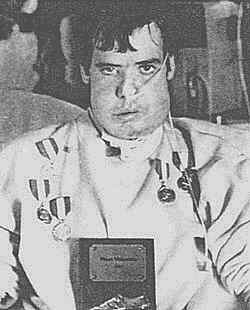 Sean Marsee, pictured here, started using oral tobacco at age 12. He was 18 when he opened his mouth and showed his mother an ugly sore on his tongue. A registered nurse, she took one look and felt her heart sink.
Sean Marsee, pictured here, started using oral tobacco at age 12. He was 18 when he opened his mouth and showed his mother an ugly sore on his tongue. A registered nurse, she took one look and felt her heart sink.
Today, oral tobacco lesions (leukoplakia) are being detected in about 1.5% of students, projected at 300,000 nationally, with substantially greater incidence among snuff than chewing tobacco users. But in only 26 per 100,000 cases each year do the white spots actually develop into oral cancer. That means that among the 5 million U.S. smokeless tobacco users, at most there are 1,300 oral cancer nightmares each year, nightmares which kill about half within five years.
Looking at such statistics, the rationalizing snuff, snus, dip or chew addict probably won't put death from oral cancer at the top of their list of concerns. Likewise, a 2.23 greater risk of sudden heart attack (four times greater for chewers who also smoke) may not be sufficient to motivate quitting without first experiencing stabbing type chest pains. Even then, getting serious about quitting often requires a doctor's "quit or drop-dead" ultimatum. But what smokeless tobacco users would be wise to note are growing concerns that long-term nicotine use may actually be eating away and destroying their brain.
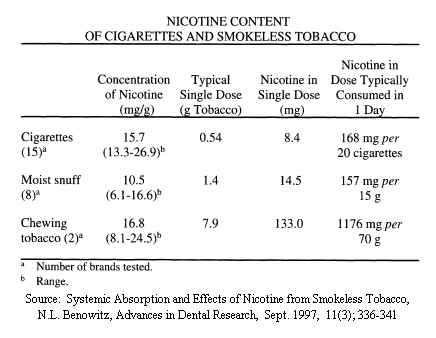
An increasing number of experiments show that long-term nicotine use reduces the number of brain neurons, increases the signs of cell death in brain tissue and impairs working memory. A September 2006 study used MRIs to examine the brains of smokers. It found significantly less brain gray matter volume and density, with loss of gray matter proportional to the number of years smoked.
According to the study's author, Dr. Jurgen Gallinat, "animal data indicate that nicotine application has brain-damaging properties. Therefore, the results of our study can be explained by effects of nicotine. This may imply that it is irrelevant if nicotine is administrated by cigarettes, chewing gum, or oral tobacco products."
Smokeless tobacco delivers high levels of nicotine quickly. Depending on your level of tolerance, blood nicotine concentrations throughout the day may actually be higher than seen in smokers.
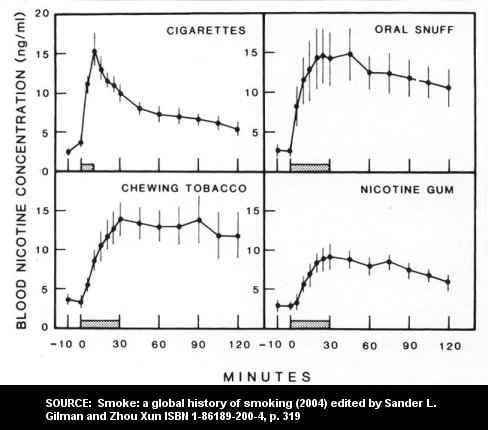
Imagine nicotine brain memory destruction being so great that you begin noticing sentences you've written are missing words, that remembering names seems nearly impossible, when you can't remember why you walked into a room or when you forget you turned on a stove burner.
Nicotine is a super toxin. Although debate about its lethalness in humans (which is difficult to prove), in animal studies nicotine has been found to be deadlier than diamondback rattlesnake venom, more lethal than strychnine and three times deadlier than arsenic. A natural insecticide, nicotine has no business inside the human mouth, bloodstream or brain. But as 90% of smokeless tobacco users have already discovered, quitting isn't easy, as nicotine is extremely addictive.
Nicotine hijacks the brain's priorities teacher, assigning nicotine use the same priority as it assigns to eating food. Wanting for food, wanting for nicotine; craves for food, craves for nicotine.
Real drug addicts in every sense, the wanting and urges felt by the nicotine addict flow from the same brain dopamine pathways as the wanting felt by the alcoholic, and the heroin or methamphetamine addict. Once hooked, the only remaining question becomes, on which side of dependency's bars will we spend the balance of life?
Your addiction long ago buried all memory of what life without nicotine was like. You begin to falsely believe that using defines who you are, gives you your edge, helps you cope, and that life without it will be horrible. Quitting fears cut both ways. You begin to fear success as much or more than failure, as your mind simply cannot imagine that life without nicotine is worth living.
The real "you" now lies buried deep beneath a pile of the most durable memories the mind may be capable of generating, dopamine "aaah" wanting satisfaction memories recorded at the moment of replenishment. Dependency researchers call the brain's dopamine pathways our "pay attention" circuitry.
These pathways are designed to ensure that species survival activities such as accomplishment, eating when hungry, drinking when thirsty, nurturing, companionship and reproduction, get noticed, are remembered and remain central to our lives. But by chance, once inside the brain, nicotine fit the receptor locks responsible for activating our dopamine pathways.
Like having every water facet in the house turned on, we experienced far more dopamine flowing for far longer than normal. But our brain fought back. The primary tactic used in specific brain regions is called upregulation, which actually leaves the brain desensitized to natural dopamine flow.
Our brain grew millions of extra receptors for nicotine in a number of different brain regions, leaving the density of receptors 100% to 300% greater than found in non-users.
This caused most of us to gradually need to use increasing amounts of nicotine in order to achieve the same "aaah" wanting satisfaction sensation. A cycle of "tolerance" was born as each time we increased our nicotine intake, our brain responded by growing or activating additional receptors, causing further de-sensitization.
Nicotine dependency recovery is a temporary journey of readjustment where the smokeless nicotine user allows their brain the time needed to physically down-regulate the number of receptors and restore natural sensitivities. It's where we develop the patience needed to allow our subconscious mind time to extinguish subconsciously conditioned nicotine feeding cues. On a conscious thinking level, it's the time and honesty needed to move beyond years of nicotine use rationalizations that attempted to justify and explain that next mandatory feeding.
Can you recall the calm and quiet that resided inside your mind before nicotine took control, going days, weeks and months without once wanting for more? It's unlikely. Those memories were quickly suppressed by more salient nicotine use memories.
Ready to return home and sample the "real" you? The below quitting tips offer the potential to make your temporary journey of recovery far less challenging than you might imagine.
We also invite you to visit WhyQuit for additional motivational resources, to download a copy of our two free ebooks, Smart Turkey and Freedom from Nicotine - The Journey Home, to watch our more than 500 free quitting videos, or to visit Turkeyville, WhyQuit's 14,000+ member Facebook's cold turkey support group.
Nicotine Dependency Recovery Tips
- Law of Addiction - The law of addiction states, "administration of a drug to an addict will cause re-establishment of chemical dependence upon the addictive substance at the old level of use or greater." Yes, just one powerful dip or chew and you'll be faced with again enduring up to 72 hours of nicotine detox. We're not that strong. Adherence to a simple restatement of the law of addiction guarantees success to all. No nicotine just one day at a time ..."Never Take Another Dip, Chew, Vape or Puff."
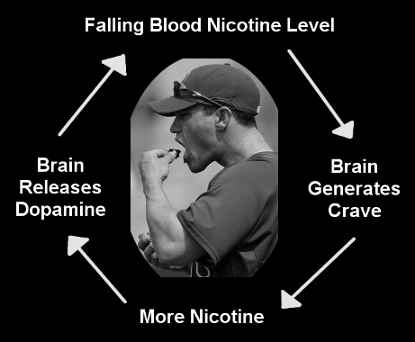
- Be Honest With Yourself - We are "REAL" drug addicts. The wanting and urges you feel for more nicotine flow from the same brain dopamine pathways as the wanting felt by the alcoholic, heroin or methamphetamine addict. And nicotine dependency is every bit as real and permanent as alcoholism. Why play games with yourself? Treating a true addiction as though some nasty little habit is a recipe for relapse. There is no such thing as just once. Recovery truly is all or nothing.
- See Cheating as Failure - Brain imaging studies teach us that just one puff and up to half of brain dopamine pathway receptors become occupied by nicotine. While most walk away from "cheating" feeling like they have gotten away with it, it isn't long before they find their brain wanting, plotting to obtain or even begging for more. Don't fall prey to the tease of "just one" or "just once." You're smarter than that (video).
- Repeat After Me - My name is ________ and I'm a REAL drug addict. Let's say it again and this time say it and mean it with every fiber of your being. My name is _________ and I am a nicotine addict. I can fully and comfortably arrest my dependency but I cannot cure or kill it. On lifetime probation, my brain will always remain grooved and wired for relapse. The only remaining question is, on which side of dependency's bars will I spend the balance of life?
- Quit Cold Turkey - contrary to pharmaceutical industry marketing hype, all but a tiny fraction of long-term successful ex-users quit cold turkey. Although few surveys exist, the rate is believed even higher for chew, dip and snus users. Education, new behavioral skills (such as adopting a one day at a time quitting philosophy) and ongoing support can dramatically increase your odds of success.
- Leave replacement nicotine alone - Smokeless tobacco users need to know that the pharmaceutical industry has not been honest about the odds of success while using nicotine replacement products (NRT) such as the patch, gum and lozenge. For example, after 30 years and billions spent marketing Nicorette, a July 2013 U.S. Gallup Poll found that only 1 in 100 successful ex-smokers credited nicotine gum for their success. A March 2003 study (Hughes) combined and averaged the seven over-the-counter nicotine patch and gum studies. It found that only 7% of study participants were still not smoking at six months. It gets worse. The odds of success appear to actually decline during a second or subsequent NRT quitting attempt. A 1993 study (Tonnesen) found that 0% of second-time patch users succeeded in quitting for 6 months and a 1995 study (Gourlay) reported a 1.6% six-month quitting rate.
- E-cigarettes a Dual Use Trap While e-cigs may seem like a way out, here's three facts to sleep on. You've always been free to use a bit less smokeless tobacco each day. How's that worked out? Second, 40-50% of smokers who turned to e-cigs to quit smoking ended up as dual users and slaves to both. Lastly, what better evidence could there be that nicotine dependency is a true mental illness than watching millions of addicts see e-cig addiction as a solution?
- Quitting for Others - You cannot quit for others. It must be your gift to you. Quitting for a child, spouse, parent or friend creates a natural sense of deprivation that is likely to ultimately end in relapse. If quitting for another person, how will an addict's junkie-mind respond the first time that person disappoints us?
- Enhancing Motivation - Having trouble getting started? Is your motivation in need of a boost? Visit WhyQuit.com and meet Sean or Gruen, or watch scores of determination fueling movie clips. If you don't have Internet access visit your local library.
- Knowledge is Power - Experience the magic of becoming vastly wiser than your addiction is strong. Visit WhyQuit.com (the source of these tips). Read our free ebooks, "Smart Turkey" and "Freedom from Nicotine - The Journey Home." Explore Joel's Library and watch his 500 free video quitting lessons, or visit Turkeyville, our 14,000+ member Facebook cold turkey support group.
- Record Your Motivations - Once in the heat of battle, it's normal for our mind to quickly forget the many reasons that motivated us to take those first brave steps. Write yourself a loving reminder letter, carry it with you, and reach for it during challenge. Make it your first line of defense: a motivational tool that pits reason against impulse. As with achievement in almost all human endeavors, the wind beneath your recovery wings will not be strength or willpower, but robust dreams and desires. Keep those dreams vibrant and on center-stage and no circumstance will deprive you of glory.
- Get Rid of All Nicotine - Keeping any kind of nicotine handy when quitting makes as much sense as someone on suicide watch keeping a loaded gun handy just to prove they can. Fully commit to going the distance and seeing what it's like to awaken to new expectations of a nicotine free mouth, mind and life. Allow yourself extra time to navigate challenges by building in delay. Flush all tobacco and replacement nicotine.
- Attitude - Almost all quitters have serious doubts starting out and it is normal to fear success as much as failure. You've actually forgotten what it is like being you. Powerful "pay attention" dopamine "aaahhh" memories have likely buried all memory of the calm and serenity of navigating life without nicotine. Greet each challenge with a can-do attitude. Try to take pride in each hour of freedom and each challenge overcome. Celebrate the full and complete victory each reflects. Yes you can!
- Patience - Years of being able to quickly satisfy our urges for more nicotine conditioned us to be extremely impatient, at least when it comes to our addiction. Realize the importance of patience to successful recovery. Baby steps, just one hour, challenge and day at a time and then celebrate. You'll never be asked to endure more than the next few minutes. They are all that matter and each is entirely do-able.
- Measuring Victory - Forget about quitting "forever." Like attempting the seemingly impossible task of sitting down to eat an entire cow or steer, it's the biggest psychological bite imaginable. Instead, like eating one nice juicy steak a day, work hard at adopting a far more manageable "one day at a time" quitting philosophy for measuring victory. If we insist on seeing success only in terms of quitting forever then on which day will we celebrate? Who is coming to that party?
- Four Recovery Layers - When quitting, the amount of nicotine remaining in your bloodstream will be cut by half every two hours. Within 72 hours all nicotine will have passed from your body and physical withdrawal will have peaked in intensity. Welcome to your new nicotine-free body and mind! Within 2 to 3 weeks your brain will have restored natural sensitivities and receptor counts. During this time expect to come to terms with the normal emotional sense of loss. Subconscious trigger reconditioning normally peaks during the first week and all but your remote, infrequent or seasonal triggers should be reconditioned within a month. Conscious thoughts of wanting will gradually grow fewer, shorter in duration and generally less intense. Within a few months they'll become the exception not the rule, as you'll gradually start to develop an expectation of going your entire day without wanting to suck or chew nicotine into your bloodstream.
- Calm Your Deep Inner Mind - The primitive subconscious mind (the lizard brain) falsely sees ending all nicotine use as though committing suicide or starving ourselves to death. It does not think, plan or plot against us but simply reacts to the years of input it has received from the mind's priorities teacher, the brain's dopamine pathways, pathways long ago taken hostage by nicotine. Use your conscious thinking mind to calm and reassure the lizard brain, especially in the fleeting seconds before dosing off into sleep. They are precious communication moments where the two draw near.
- Withdrawal Symptoms - Within reason it's fairly safe to blame most of what you'll feel during the first three days on quitting. But after that you need to listen to your body and if concerned give your doctor a call. Don't blame your symptoms on where you're going but on where you've been. See each symptom as the true sign of healing it reflects.
- Possible Hidden Conditions - Smokeless tobacco contains more than 4,200 chemicals including 28 carcinogens. One or more of these 4,200 chemicals may have been masking an underlying hidden health problem. Snuff or chew chemicals may also have been interacting with medications you were taking and an adjustment may be necessary. Stay alert and if at all concerned immediately contact your physician or pharmacist.
- Do Not Skip Meals - Each dip or chew of nicotine was our spoon, releasing stored fats into our bloodstream. It allowed us to skip meals without experiencing wild blood-sugar swing symptoms such as an inability to concentrate or hunger related anxieties. Learn to again properly fuel your body by spreading out your normal daily calorie intake more evenly. Try not to skip meals.
- Three Days of Natural Juices - Unless diabetic, drink plenty of acidic fruit juice the first three days. Cranberry is excellent and a bottle will cost about the same as a tin of dip. The acidic juices will not only aid in more quickly removing the alkaloid nicotine, it will help stabilize blood sugars. Take care beyond three days as juices tend to be rather fattening.
- Weight Control - You'd need to gain at least 75 extra pounds in order to equal the health risks associated with smoking one pack-a-day. Eat vegetables and fruits instead of candies, chips and pastries to help avoid weight gain. Engage in some form of moderate daily exercise if at all concerned about weight gain.
- Stress Related Anxieties - Recognize that contrary to popular thinking, oral nicotine did not relieve stress but only its own absence. Nicotine is an alkaloid. Stress is an acid-producing event capable of quickly neutralizing the body's nicotine reserves. As nicotine addicts we added early withdrawal to every stressful event. You will soon discover an amazing sense of calm during crisis. There are a host of anxiety management techniques you can employ during this temporary journey of re-adjustment called "quitting," including the practice of slow deep breathing while focusing your mind on your favorite object, place or person to the exclusion of other thoughts.
- Caffeine/Nicotine Interaction - Amazingly, nicotine somehow doubles the rate by which the body depletes caffeine. Studies have found that your blood-caffeine level will rise to 203% of your normal baseline if no intake reduction is made when quitting. Although not a problem for most light to moderate caffeine users, consider a caffeine intake reduction if troubled by anxieties or if experiencing difficulty relaxing or sleeping.
- Emotional Phases - Chemical dependency upon oral nicotine is one of the most intense, repetitive and dependable relationships you've likely ever known. It has infected almost every aspect of your life. Be prepared to experience a normal sense of emotional loss when quitting. Expect to travel through and experience six different emotional phases: (1) denial, (2) anger, (3) bargaining, (4) depression, (5) acceptance, and (6) complacency.
- Subconscious Nicotine Triggers - You have conditioned your subconscious mind to expect nicotine when encountering certain locations, times, events, people or emotions. Be prepared for each to trigger a brief crave episode. Encountering a trigger cannot trigger relapse unless nicotine enters your bloodstream. But take heart. Most triggers are reconditioned and extinguished by a single encounter during which the subconscious mind fails to receive the expected result - nicotine.
- Crave Episodes Peak Within 3-5 Minutes - In contrast to conscious thought fixation (the "nice juicy steak" type thinking that can last as long as you have the ability to maintain your focus and concentration), it is rare when any subconsciously triggered crave episode lasts longer than five minutes. If it should happen it could indicate that you encountered two triggers in close proximity to each other, and have reclaimed two aspects of life.
- Expect Time Distortion - Studies teach us that nicotine cessation causes serious time distortion. Although crave episodes are generally less than three minutes, recovery time distortion can make minutes can feel like hours. Keep a clock or watch handy to maintain an honest perspective on time.
- Crave Episode Frequency - Unless hiding in a closet, you'll likely experience the greatest number of triggers around day three. Although no crave episode frequency studies are reported for oral tobacco users, the average nicotine smoker reports a peak of six crave episodes on day 3. That's a total of 18-30 minutes of challenge on their most challenging day. But what if you're not average? What if you established and must encounter twice as many nicotine-feeding cues as the average quitter? That's 36-60 minutes of significant challenge. Can you handle 60 minutes of serious desire in order to reclaim your mouth, mind and life? Absolutely! We all can. Be prepared for a small spike in crave episodes on day seven as you celebrate your first full week of freedom from nicotine. Yes, for most of us, nicotine use was part of celebration too. Also, stay alert for subtle differences between crave triggers. For example, the Sunday newspaper is much thicker and may have required a bit more nicotine to read.
- Understanding the Big Crave - In the above discussed smoker study, the average quitter was experiencing just 1.4 crave episodes per day by day ten. Shortly thereafter it isn't unusual to start experiencing entire days without encountering a single un-reconditioned subconscious crave trigger. If a later crave episode ever feels far more intense it's likely that it has been some time since your last significant challenge and you've dropped your guard and defenses a bit. It can almost feel as though you've been sucker punched. If this should occur, stop and reflect on how long it has been since your last significant challenge. If significant, see your sucker punch as the wonderful sign of healing it reflects.
- Confront Your Crave Triggers - Recognize the fact that everything you did as a smokeless user you will learn to again comfortably do as an ex-user. Meet, greet and defeat your triggers. Don't hide from them. You need not give up anything when quitting except nicotine. Everything you did as a nicotine user you'll soon discover can be done as well or better as a non-user. With each trigger extinguished you receive a prize, another piece of a puzzle that once complete will reflect you comfortably and confidently engaging all aspects of life.
- Alcohol Use - Be extremely careful with early alcohol use during the first couple of weeks. Relapse studies teach us that alcohol use is associated with roughly half of all relapses. Using an inhibition diminishing substance and then intentionally surrounding yourself with smokeless nicotine users (or nicotine smokers) while still engaged in early withdrawal is a recipe for relapse. Get your quitting feet under you first. If an alcohol user, once ready to challenge your drinking triggers consider breaking the challenge down into smaller more manageable trigger segments. Consider drinking at home first without nicotine around, or going out but refraining from drinking, or spacing your drinks further apart, or drinking water or juice between drinks. Have an escape plan and a backup, and be fully prepared to use both. If a problem drinker, reflect on the possibility that you may be dealing with two issues.
- Distraction Crave Coping - Distraction or diversion crave coping is any mental exercise or physical activity that occupies the conscious mind long enough to allow challenge to pass. For example, a popular 3-5 minute coping exercise is to say your ABCs while associating each letter with your favorite food, person or place. For example, the letter "A" is for grandmother's hot apple pie. "B" is for warm buttered biscuits. You may never reach the challenging letter "Q" before the challenge passes.
- Relaxation Crave Coping - Three relaxation exercises that can be practiced and called upon as nicotine cessation crave coping strategies: (1) slow deep breathing [audio exercise #1, audio exercise #2]; (2) progressive muscle relaxation [audio exercise ]; and (3) guided imagery [audio exercise]. It is not normal to breathe deeply. Most of us breathe from the chest. It's called shallow breathing. When you breathe deeply, your body takes in more oxygen and you exhale more carbon dioxide. The body "resets" itself to a more relaxed and calm state.
- Mindfulness Crave Coping - Mindfulness is the quality or state of being conscious or aware of something, a mental state achieved by focusing one's awareness on the present moment, while calmly acknowledging and accepting one's feelings, thoughts, and bodily sensations [audio exercise]. While engaging in slow deep breathing, remain aware and monitor your crave. Accept your thoughts and feelings about the crave without judging them. And see yourself as being separate from the craving.
- Embracing Craves - One mindfulness strategy is to to mentally reach out and embrace your craves. A crave cannot cut you, burn you, kill you, or make you bleed. Try to be brave just once. In your mind, wrap your arms around the crave's anxiety energy and then feel as it slowly fizzles while within your embrace. Yes, another trigger bites the dust as you reclaim yet another aspect of life!
- Support Expectations - Don't expect family or friends who have never been chemically dependent themselves to have any appreciation of your challenges or the time required to achieve substantial comfort. It simply isn't fair to them or you. Find a recovered nicotine addict and ask them if they'd mind being your mentor for the next 90 days. You can also read or join and participate at Turkeyville, our Facebook support group.
- No Legitimate Excuse for Relapse - Recognize that using nicotine cannot solve any crisis. All it will do is add active drug addiction to your list of concerns. Fully accept the fact that there is absolutely no legitimate excuse for relapse, including an auto accident, financial crisis, the end of a relationship, job loss, a terrorist attack, a hurricane, the birth of a baby, or the eventual inevitable death of those we love most. Picture yourself not using nicotine through each and every step needed to overcome the most difficult challenge your mind can possibly imagine.
- Conscious Thought Fixation - Unlike a less than three-minute subconscious crave episode, we can consciously fixate on any thought of wanting to use nicotine for as long as we're able to maintain our concentration. Don't try to run or hide from thoughts of wanting but instead place the thought under honest light. Flavor? If your use is about flavor then why can't you simply and easily substitute a flavor that isn't addictive? Just "one" pinch, pouch, dip or chew? For us nicotine addicts, one is too many and a thousand never enough. Treat nicotine dependency recovery as if it were no different than alcoholism. See a bright line in the sand. Don't debate with yourself about wanting "a" nicotine fix. Instead, ask yourself how you'd feel about having "all" of them back, about returning to your old level of nicotine consumption or greater.
- Reward Yourself - Consider putting aside the money that you would have spent buying nicotine and after a week or month treat yourself to something you really want. Save for a year and go on a vacation.
- Fully Commit To Going the Distance - Don't be afraid to tell people around you that you have arrested your dependency and are back in charge. Otherwise any wild emotional swings during early recovery may leave them thinking you are using some form of drugs instead of coming off of one. Their understanding and support could be beneficial. Fully commit to recovery while taking pride in each and every hour and day of freedom from nicotine, and each challenge overcome. Gradually shed false yet natural fears that nicotine defined your very being, that you'd be leaving a major part of you behind, and that life without nicotine just wouldn't be nearly as good. Even the love in your heart, you get to bring it with you!
- Avoid All Crutches - A crutch is any form of quitting reliance that you lean upon so heavily in supporting your quit that if quickly removed would likely result in relapse. Do not lean heavily upon a quitting buddy who quits at the same time as you. If not schooled in nicotine dependency recovery, their odds of successfully quitting for one year are relatively small. Instead, ask an ex-smokeless tobacco user or ex-smoker or never-smoker for support, or visit a free online support forums such as Turkeyville.
- The Smoking Dream - Be prepared for an extremely vivid nicotine-use dream as tobacco tars released by healing tissues come in contact with vastly enhanced senses of smell and taste. See it as the wonderful sign of healing it reflects and nothing more. You're safe so long as use dreams remain nightmares.
 See Marketing as Bait - Your quitting means thousands of dollars in lost profits to the nicotine industry. They do not want to lose you. See store tobacco advertising and the hundreds of neatly aligned cans, pouches and packs for what they truly reflect - bait. Inside the pretty colored cans and among the hundreds of flavor additives is hidden what many dependency experts now consider earth's most captivating chemical. Don't be afraid to visit the store where you purchased your snuff, snus or chewing tobacco. You need to meet, greet and defeat that trigger too!
See Marketing as Bait - Your quitting means thousands of dollars in lost profits to the nicotine industry. They do not want to lose you. See store tobacco advertising and the hundreds of neatly aligned cans, pouches and packs for what they truly reflect - bait. Inside the pretty colored cans and among the hundreds of flavor additives is hidden what many dependency experts now consider earth's most captivating chemical. Don't be afraid to visit the store where you purchased your snuff, snus or chewing tobacco. You need to meet, greet and defeat that trigger too!- "Safer" Marketing Ploy - The smokeless tobacco industry wants you to take comfort in the fact that using Kodiak, Grizzly, Skoal, Wolf, Longhorn, Red Seal, Copenhagen, Rooster, Lucky Strike, Bacco, Onxy, Cougar, Gold River, Hawken, Beech-Nut, Chattanooga, Redwood, Silver Creek, Red Man, Granger, J.D.'s Blend, Lancaster, and Levi Garrett is safer than smoking. While true, it's also true that using any brand of smokeless tobacco is light years away from being safe. Losing your dollars means losing thousands in profits and they're fighting hard to keep you hooked. But there's an old saying, "Fool me once, shame on you. Fool me twice, shame on me!"
- Watch Nicotine Addicts Closely - They are not dipping, chewing, vaping or smoking to tease you. They do so because they must, in order to replenish a constantly falling blood-serum nicotine level that declines by half every two hours. Most nicotine is used while on autopilot. What cue triggered the public feeding you're now witnessing? Watch acid-producing events such as stress or alcohol quickly neutralize their body's nicotine reserves. Witness their endless mandatory cycle of replenishment.
- Thinking vs. Wanting - There is a major distinction between thinking about the subject of quitting and wanting to use nicotine. After years of chronic nicotine use you should expect to notice others using nicotine but it doesn't necessarily mean that you want to. As for thoughts of wanting, with each passing day they'll gradually grow shorter in duration, generally less intense and a bit further apart.
- Non-User or Ex-User - What should you call yourself? Although it's normal to want to see yourself as a non-user, there is a major distinction between a never-user and an ex-user. Only the ex-user can grow complacent, use nicotine, and relapse. "My name is ______ and while I'm a non-user, I prefer to refer to myself as an ex-user because it reminds me that I'm just one nicotine-fix away from destroying one of the greatest accomplishments of my life."
- Avoiding Complacency - Don't allow complacency to destroy your healing and glory. The ingredients for relapse include a failing memory of why we quit and of the early challenges, rewriting the "Law of Addiction" so as to exempt or exclude ourselves, and an excuse such as stress, celebration, illness, finances, weather, terrorism, war, death, or even a cigar at the birth of a baby.
- Relapse - Remember that there are only two good reasons to use snuff, snus or chewing tobacco once you quit. You decide you want to go back to your old level of consumption (or more) and continue to gradually damage your mouth, body and mind, or you decide that you really enjoy withdrawal and you want to make it last forever.
- Only One Rule - So long as neither of the above two options appeal to you there is just one guiding principle that will 100% guarantee your continuing freedom ... no nicotine just one day at a time, Never Take Another Dip, Chew or Puff!
About These Quitting Tips
This quitting tips list was authored by John R. Polito, a recovered nicotine addict, nicotine cessation educator and editor of whyquit.com. These tips are primarily a product of medical studies and lessons from Joel's Library ( https://whyquit.com/joel ), an insightful collection of 95 short quitting articles available for download as a free electronic PDF book at WhyQuit.com (https://whyquit.com/joel/). While there, watch a few of Joel's nearly 500 video quitting lessons.
Be sure to print and share or e-mail these quitting tips to friends and loved ones addicted to nicotine. Not discovering the "Law of Addiction" through the school of hard-quitting-knocks or learning it from booklets such as this is a horrible reason to watch a once sharp mind gradually lose its edge. These quitting tips may be reproduced and shared for all health education purposes, so long as it there is never any charge or cost to recipients. Comments may be addressed to John R. Polito, 108 Aldrich Place, Goose Creek, SC 29445, (843) 797-3234 or via email to john@whyquit.com.
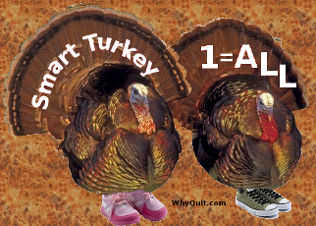
Learn More About SmartTurkey
-
WhyQuit.com WhyQuit is the Internet's oldest forum devoted to the art, science and psychology of cold turkey quitting, the stop smoking method used by the vast majority of all successful long-term ex-smokers. Left to right, WhyQuit is organized under three headings: (1) Motivation, (2) Education and (3) Support.
- Joel's Library Joel's Library is home to Joel Spitzer's "Daily Quitting Lesson Guide." The Guide walks new quitters through the first two weeks of smoking cessation, recommending daily videos to watch and articles to read. Joel's Library is also home to more than 100 original short stop smoking articles, to his free ebook Never Take Another Puff, and to his collection of nearly 500 video stop smoking lessons.
- Never Take Another Puff Imagine a free 149 page stop smoking ebook that's registered more than 4 million downloads and was written by a man who has devoted 40 years, full-time to helping smokers quit. Never Take Another Puff (NTAP) was authored by Joel Spitzer, the Internet's leading authority on how to stop smoking cold turkey. It is an insightful collection of almost 100 articles on every cessation topic imaginable.
- Freedom from Nicotine - The Journey Home Written by John R. Polito, a former 30-year heavy smoker and WhyQuit's 1999 founder, Freedom from Nicotine (FFN) is a free 400 page nicotine dependency recovery book that documents the science underlying nicotine dependency and successful cessation.
 Whether hooked on cigarettes, e-cigarettes (e-cigs), bidis, kreteks, a pipe, hookah or cigars, on dip, chew, snuff or snus, or on the nicotine gum, lozenge, spray, inhaler or patch, FFN provides a comprehensive yet easy to follow road-map to freedom from nicotine.
Whether hooked on cigarettes, e-cigarettes (e-cigs), bidis, kreteks, a pipe, hookah or cigars, on dip, chew, snuff or snus, or on the nicotine gum, lozenge, spray, inhaler or patch, FFN provides a comprehensive yet easy to follow road-map to freedom from nicotine.
- Turkeyville Visit Turkeyville, Facebook's most popular quit smoking support group. The group's primary focus is the first few days and helping new quitters get started. Yes you can!
- Nicotine Addiction 101 WhyQuit's guide to understanding nicotine dependency.
- Nicotine Cessation Topic Index An alphabetical subject matter index to hundreds of nicotine cessation support group discussions, article and videos.
- 50 Quitting Tips Key cold turkey nicotine cessation tips on how to stop smoking, vaping, chewing or sucking nicotine into your body and bloodstream.
Knowledge is a Quitting Method
